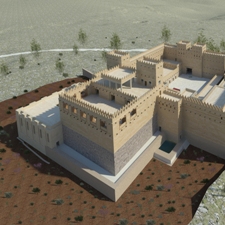I wrote about the rediscovered garden at Ramat Rachel (or: Ramat Rahel) earlier. The tone of that post was negative, not because of the find itself, but because a representation of what the garden might have looked like was created, that made no sense. All for PR-purposes.  It’s OK to use an example from another location, but just refer to the original, do not create a bad drawing of it and try to ‘sell’ it as an original. That was my whole point.
It’s OK to use an example from another location, but just refer to the original, do not create a bad drawing of it and try to ‘sell’ it as an original. That was my whole point.
Luckily, the archaeologists were not deterred by my critique (no reason to) and happily kept on working. They now have come up with news that is unmistakenly spectacular: analysis of pollen entrapped in layers of plaster in the garden’s irrigation system has revealed which plants populated the garden around 2500 years ago (via). And because the layers of plaster can be rudimentarily dated, they are also able to tell when variations in the planting took place.
In other words: it is possible to date the introduction of exotics at Ramat Rachel. The finds thusfar show that periods in which only indigenous plants occupied the garden, alternate with periods in which all kinds of exotic species were planted in the garden. The rise and decline in the life of a garden can thus be exposed.
From the announcement:
Among the unusual vegetation are willow and poplar, which required irrigation in order to grow in the garden; ornamentals such as myrtle and water lilies; native fruit trees including the grape vine, the common fig, and the olive; and imported citron, Persian walnut, cedar of Lebanon, and birch trees. Researchers theorize that these exotics were imported by the ruling Persian authorities from remote parts of the empire to flaunt the power of their imperial administration.
I hope this success inspires garden researchers in The Netherlands. Many country houses (originally built in brick) were plastered at the end of the 18th and in the early 19th century, thus trapping the pollen of the plants that surrounded the buildings in the previous years. Analysis of that pollen could give us a (much needed) better idea of the assortment used in -for example- the early landscape period gardens of the time.
Unfortunately, many of those original plaster layers have been removed since. In some cases for restauration purposes, in some cases to expose the underlying brick walls in an attempt to show the original building. The big question is: are there any original plaster layers from that period left?


